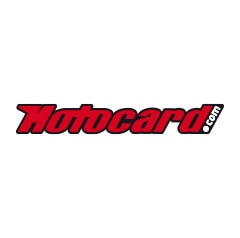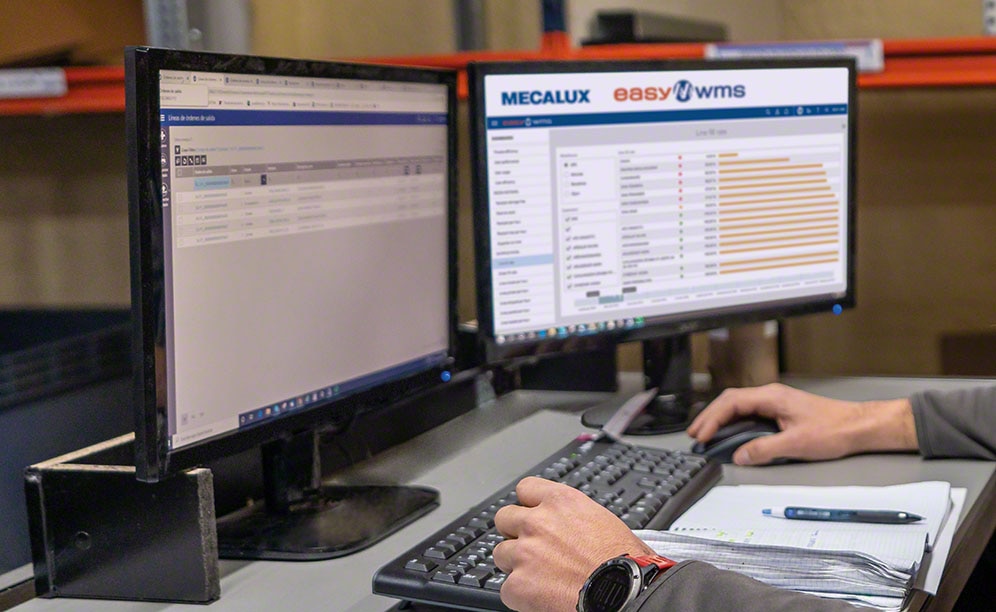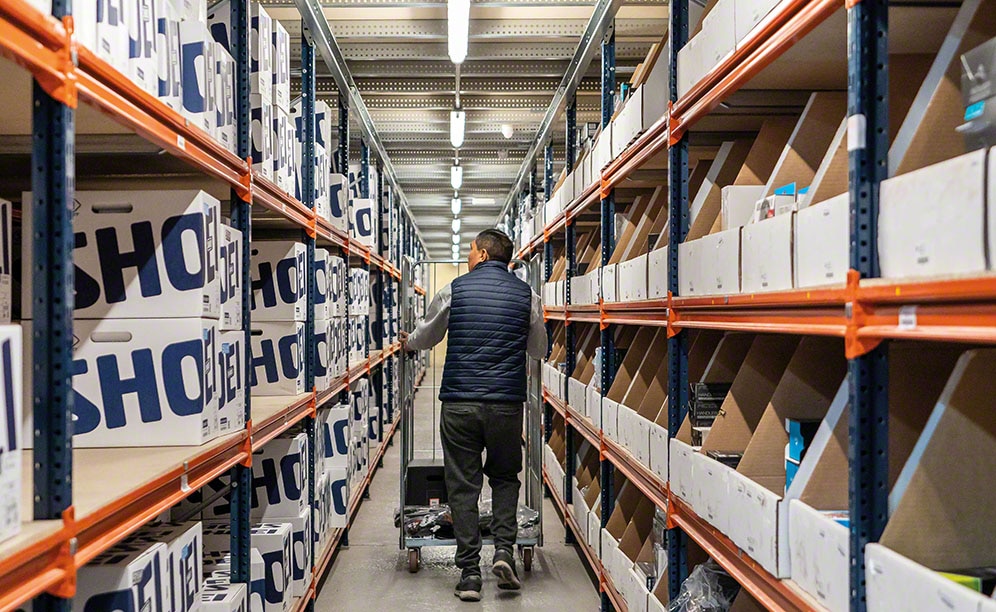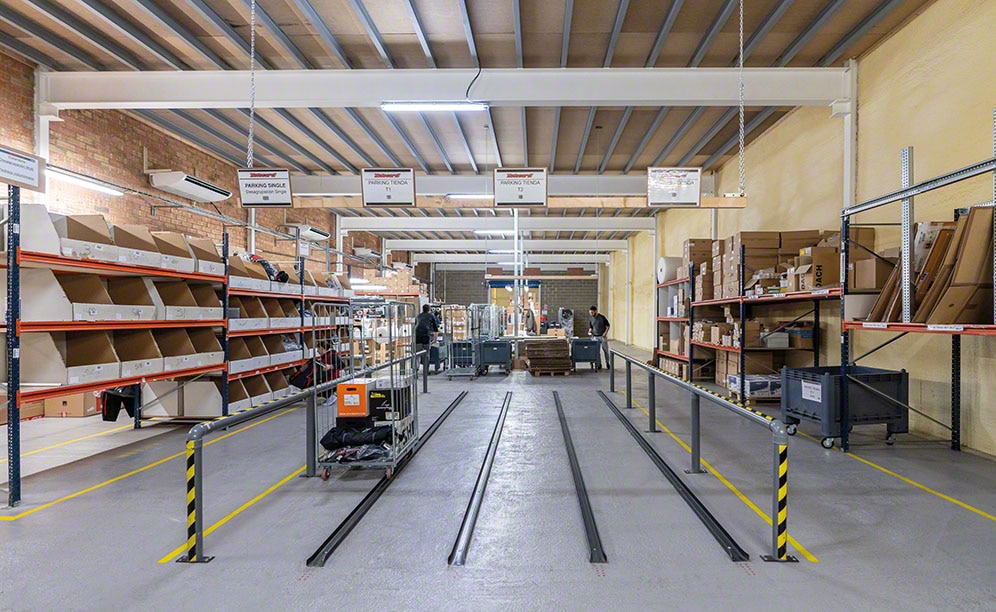
Efficiency in Motocard's omnichannel warehouse in Spain
The motorcycle gear company has revamped its warehouse to supply shops and e-customers

Motocard, a leading European chain specialising in equipment and accessories for motorcyclists, has registered incomparable growth in recent years, driven particularly by its online sales channel. However, the demanding requirements of its e-commerce business were putting its logistics systems to the test and even limiting the firm’s expansion. Aware of this, Motocard decided to revamp its supply chain completely and transform its distribution centre, turning it into a true omnichannel warehouse. From there, it distributes 900 daily orders to both shops and e-customers. To accomplish this, Motocard has relied on the storage and software solutions of its strategic partner Mecalux. As a result, it has optimised the space dedicated to multi-unit orders and can now dispatch online orders in less than 24 hours, in addition to taking inventory in half the time.
Omnichannel test: passed
More than a business, Motorcard is a meeting point for those with the need for speed and, specifically, fans of the twowheeled vehicle variety. Founded in 1982 in Andorra, it is the top firm at European level in the distribution of motorcycle gear and clothing.
Currently, Motocard has 12 sales outlets throughout Spain and Andorra. In 2002, it penetrated the e-commerce market with the opening of an online shop. There, it provides uninterrupted service to any customer where required.
Over the past few years, Motocard’s online sales have risen by 25%. Since the company’s main 4,500 m² en Solsona warehouse in northern Spain was initially designed to supply physical shops, it had to be adapted to Motocard’s new business strategy: omnichannel retailing.
Omnichannel retailing improves the customer experience because people can choose from amongst multiple purchasing options. For example, they can go to any of the brickand-mortar shops Motocard has in Spain and Andorra. Meanwhile, if they prefer, they can connect to the website, select the product of their choice and have it delivered to their homes, to a collection point or to a physical Motocard shop.
From a logistics point of view, this change posed an enormous challenge to Motocard: it needed space and agility to prepare all those orders (from the website and the shops) and dispatch them in the shortest possible time.
“We had the capacity to process a limited number of orders. When they started to grow, we were forced to take on more staff and modify some of the processes. What we were really looking to do, though, was improve the efficiency of our entire supply chain. It was then that we seriously thought about implementing a warehouse management system (WMS),” explains Jordi Colilles, Digital Director of Motocard.
The company opted for Easy WMS, the WMS by Mecalux, together with two modules that enable it to manage the storage circumstances dictated by omnichannel retailing.
- WMS for e-commerce: charged with ensuring the scalability of the online business and sorting and grouping products based on whether they belong to single- or multi-unit orders.
- Multi Carrier Shipping: facilitates communication with transport agencies that work with Motocard so that the carriers know in advance which orders should be delivered in each shipment. This software generates a shipment tracking code so that customers can consult the whereabouts of their package at all times.
According to Jordi Colilles, “we leveraged the implementation of Easy WMS to transform the warehouse physically and improve operations relating to entry, reverse-logistics, picking and dispatch processes.”
The installation now has an ample storage area with picking shelves with walkways by Mecalux. It consists of high-bay shelving that supports raised aisles making up three floors. In total, the shelves hold 15,000 items with their corresponding sizes.
One advantage of this solution is that it makes the most of the building’s height to provide increased capacity the warehouse surface area has tripled). The shelving also stands out for its versatility, adapting to a huge variety of available products with different volumes and turnover rates. This system enables direct access to the goods, a key factor in streamlining the storage and picking tasks.
A dispatch and consolidation area has been set up where the largest amount of work is carried out. There, Mecalux has installed pigeonholes for multi-unit orders. Just alongside them, carts with finished products from the warehouse are grouped into four rows: two for orders for shops, one for multi-unit orders and one for single-unit orders.
This area also includes workstations where operators verify and close orders, ensuring that they are accurate and that no products are missing. Finally, the goods are packaged and wrapped, and the packing lists and shipping labels are printed.
At each station, everything the operators use to carry out their work is very carefully organised: computer, printer, seals, scissors, box cutters, etc. The objective is to prevent distractions and for operators to concentrate on finishing as many orders as possible. Here is where the lean methodology comes into play: improving and optimising all warehouse processes using only those resources that are indispensable. The ultimate goal is to promote activities that provide more value.
In terms of operations, Easy WMS has boosted order preparation. Every day, a total of 900 orders are closed: 40% from e-sales and 60% from brick-and-mortar shops. Half of all online sales are shipped abroad.
Xavier Jounou - Motocard warehouse manager
“Easy WMS helped us meet our objective: to concentrate practically all dispatches in our central warehouse in Solsona (Spain). This is possible thanks to the optimal organisation of all our SKUs and increased efficiency in order preparation.”
Goods receipt
The warehouse has a receipt area where all the products that arrive every day are delivered. Using radiofrequency terminals, operators identify and sort each item. There are three types of entries:
- Suppliers. This merchandise can form part of a pending order or be directly stored to be used as reserve product.
- Motocard installations. Warehouse manager Xavier Jounou explains, “We sell all the products you see on our website, whether or not they are in stock at our main warehouse. If we need an item that another Motocard installation has in its inventory, they send it to us to complete the order.” All these goods are placed in a cross-docking area because, Jounou says, “we know they make up part of an order. In addition, when organising the routes of order prep operators, the WMS ensures that this merchandise is picked first.”
- Returns. Operators use the RF terminals to identify each item and check its condition. Finally, Easy WMS decides on a location for it.
Order preparation and dispatch
There are two types of orders, based on their destination: orders for shops (products that have been sold and are replenished weekly) and orders for online customers. The latter can be single-unit or multi-unit.
Easy WMS groups the orders and assigns a cart to an operator, who uses it to walk around the warehouse, locating the required SKUs. As the WMS knows the cart capacity, it organises the work accordingly. “For example, if a cart has a maximum capacity of 20 boxes, the WMS ensures that only that amount is picked, regardless of whether the orders are single- or multiunit,” points out the warehouse manager.
Using radiofrequency terminals, the operators go up and down the different floors of the installation, picking the products. The route begins at the cross-docking area and ends at the dispatch zone. Xavier Jounou notes, “Easy WMS is so intuitive that it is actually really hard for workers to make mistakes.”
Four operators prepare solely and exclusively the orders sent to the shops, while the other workers prepare the online orders. “Thursday is our critical day: the shops need merchandise for the weekend (when the largest volume of sales takes place), and e-customers usually order a larger amount of items to enjoy on their days off,” affirms the warehouse manager.
Numerous single- and multi-unit orders are prepared on a daily basis. The consolidation of single-unit parcels is much quicker, as these merely have to be checked, packaged and labelled.
Multi-unit shipments, meanwhile, are more complex. The workstations where these orders are closed are right next to the pigeonholes “for convenience and for operators to move around less,” says Xavier Jounou. In these pigeonholes, each slot corresponds to an order. All the products that make up an order are deposited in these locations. The WMS tells the operators exactly where to place each item. Once the order is completed, the WMS directs it to be sent to the packaging area.
In this zone, the delivery note is printed, and the products are placed inside the boxes. These are then sealed, and their labels are affixed. Immediately afterwards, the operators put the boxes on a conveyor, which moves them to the dispatch area. There, a worker groups the boxes on the corresponding pallet, depending on whether they will be distributed by UPS, DHL or SEUR. “Thanks to the Multi Carrier Shipping module, Easy WMS knows in advance which agency will ship each order. Thus, it generates and prints a personalised label the moment the box is closed,” notes Xavier Jounou.
Advantages of Easy WMS
The WMS by Mecalux has underpinned the company’s growth and given it the following advantages:
From paper to digitalisation
Jordi Colilles, Digital Director of Motocard, affirms, “The most obvious change for us was going from paper-based to completely digital management.”
Previously, in terms of administration, delivery notes were created as orders were received. Warehouse staff would then go pick the items and begin to prepare the orders. “This caused many bottlenecks because operators couldn’t begin preparing the orders until all the paperwork was generated. Orders that we received mid-morning, for example, were not processed until the afternoon,” adds the Digital Director.
The use of paper slowed down installation operations, and workers could end up making mistakes. “In dispatches, they wasted a lot of time looking for the delivery note and corresponding label for each order. As a result, it was impossible to deliver orders the same day they were received, which was beginning to hold us back,” admits Jordi Colilles.
Digitisation has boosted order prep. Now, Motocard’s logistics revolves around orders, and all the machinery is set in motion when the goods are available. “No operator movements are made for an order that we know cannot be completed. The moment the products are in the warehouse, the operator begins preparing the order,” points out the Digital Director.
Maximising space and flexibility
When preparing multi-unit orders without the help of Easy WMS, almost half of the installation was used to store incomplete orders temporarily. Now, no unfinished orders are housed; there are merely 64 slots in the pigeonholes, very close to the dispatch area, where various items making up the same order are grouped together.
Making the most of this warehouse space minimises operator movements and, thus, speeds up order prep. For instance, all the workstations for order verification and consolidation have been set up on the ground floor.
Easy WMS also designs operator routes, optimising movements when storing goods and preparing orders. “For us, it is more effective for operators to move between the various floors. On high activity days, though, we can work by floor, whereby workers prepare their orders only on the floor assigned to them,” highlights Jordi Colilles.
Accurate goods control
Motocard’s stock is spread out over multiple premises. Depending on its location, the website shows clients one delivery date or another.
“One of the huge differences we have noticed with Easy WMS is that we know the exact location of our 15,000 items in real time,” enthuses Motocard’s Digital Director.
To achieve this, the products need to be identified by EAN13 barcodes, which the operators scan with radiofrequency terminals the moment the goods arrive at the warehouse. Easy WMS then assigns each product a location according to its type and brand.
This control enables Motocard to take inventory more quickly. “On paper, it used to take us three days to count all the stock. By contrast, our last inventory was made by a team of temporary external employees in only a day and a half. They were taught how to use Easy WMS and, within just a few hours, they had it under their belts. We are more than satisfied because this has translated into cost savings,” stresses Jordi Colilles.
Deliveries from zero to sixty
Delivering orders on time is one of Motocard’s priorities. According to Jordi Colilles, “we can deliver online orders in under 12 hours. To do this, we prepare the largest number of orders possible before 6.30 p.m. (when the carriers arrive). We are able to dispatch 90% of the products customers buy before noon that same day.” With this work system, users receive their purchases the following morning.
A major tune-up leads to growth
The deployment of Easy WMS has marked a before and after in Motocard’s logistics. The supervision of the WMS and optimisation of operator routes have benefited the company enormously, making storage and order prep tasks much more dynamic. Likewise, digitalising its logistics operations with Easy WMS has revitalised Motocard’s entire supply chain.
“We have absorbed the 25% growth in the number of online orders. We had our stress test last Black Friday, and we passed it with flying colours. Throughout that week — with a huge number of orders to prepare — we increased our productivity by 75%,” asserts Jordi Colilles. This indicator shows that, with less resources, operators achieved 75% more; that is, they prepared more orders (up to 2,000 per day) quickly and efficiently.
Jordi Colilles - Digital Director of Motocard
“Before, it was impossible for us to deliver orders the same day the customers requested them. This was beginning to hinder our business. With Easy WMS, we have streamlined all our processes. Consequently, 90% of the goods ordered before noon are dispatched that same day.”
Advantages for Motocard
- Order-oriented logistics: Easy WMS organises the preparation of 900 daily orders (for both shops and online customers) from the moment the necessary merchandise is available.
- Flexible system: operators prepare orders on all the floors of the warehouse. On high activity days, they can work by floor, preparing orders exclusively on the level assigned to them.
- Inventory control: the WMS knows the exact location of the 15,000 available items.
Gallery

Ask an expert







